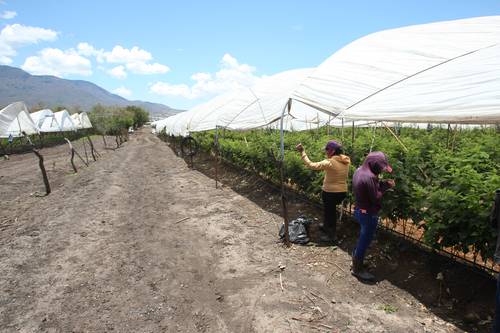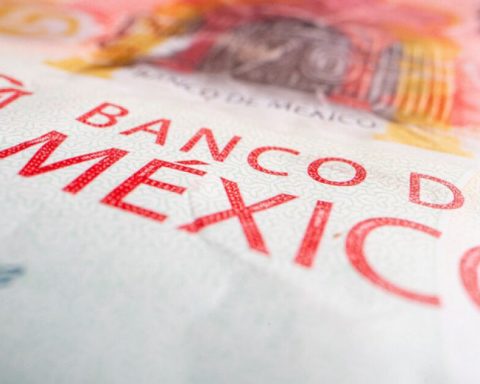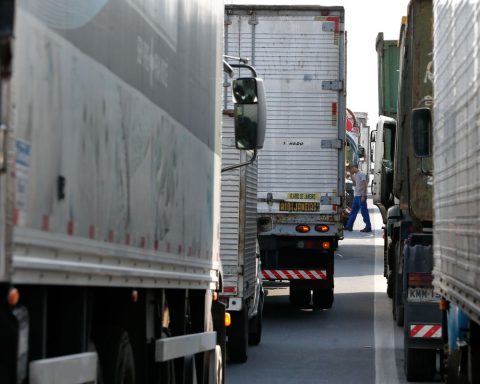▲ The export agro-industrial model requires greater investment in technology, infrastructure and water. The impossibility of complying with this leads small producers to rent their land.Photo Luis Castillo
Braulio Carbajal
Newspaper La Jornada
Wednesday, November 2, 2022, p. two
Mexico ranks 12th among the largest food producers in the world. However, in the recent year it made record imports of basic products in the national diet, such as corn, a fact that makes consumption more expensive for its inhabitants, more so at a time when global inflation is the highest in four decades. The panorama of food production in the country has deteriorated over the last few decades. In that time, the activity in the field has turned towards a model that gives priority to export crops, which generate greater income for the large companies in the sector, over those considered basic in the diet of the Mexican population.
Data from the Agri-Food and Fisheries Information Service (SIAP) reveal that from 2000 to the end of 2021, the area destined for planting basic grains, such as corn, beans, wheat, rice, coffee and sorghum, shows a decrease of 16.8 percent. hundred; In contrast, and during the same period, that used to produce avocado, agave, barley, tomato, raspberry, strawberry and blackberry has skyrocketed 40 percent.
The effects of this change of course are more visible in an environment like the current one, in which Mexico registers unprecedented spending on the acquisition of basic grains from abroad, making the basic food basket more expensive by around 15 percent.
This model promotes a change in tenure for the use of the land. The export agro-industrial model demands greater amounts of capital, technology, infrastructure and water, which small producers cannot provide on many occasions. The impossibility of complying with these conditions leads them to rent the land. This production model does not necessarily require ownership of the land, and renting it allows them to overexploit it without having to pay the environmental costs of using water extensively.
Meanwhile, according to figures from the Bank of Mexico (BdeM), products such as beer (derived from barley), tequila (made with agave), avocado and berriesmarketed mainly by large companies, have a record in the value of their exports, representing around a third of the total income received by the country from the sale of agri-food abroad.
Behind the growth of these exports are large companies, such as the largest exporters of beer (the best-selling agro-industrial product in Mexico), Grupo Modelo and Cervecería Cuauhtémoc Moctezuma. The first belongs to the Belgian Anheuser-Busch InBev and the second to the Dutch Heineken.
On the tequila side, the dominant brands are José Cuervo and Sauza, from the companies José Cuervo and Suntory Holding, respectively.
On the avocado side, 80 percent of the market is dominated by the state of Michoacán, where companies such as Del Monte, Bonanza, Hahena, Fresh Directions, Camposanto, AgriFrut, Avo Hass and B & M Fresh stand out, among others.
In the branch of berries stand out the members of the National Association of Exporters of Berriessuch as Berrymex, Agrana, California Giant Berry Farms, Cofrusa, Driscoll’s, Hortifrut, Andrew & Williamson Berry Farms, BQ Fruits, to name a few.
promoted imports
Laura Moreno Altamirano, researcher at the National Autonomous University of Mexico (UNAM) and author of Economic structure, income distribution, eating patterns and nutritional conditions in Mexicopoints out that the policies of the different governments have favored the neglect of agriculture, which has promoted the increase in agri-food imports.
In this sense, the specialist emphasizes in her research that official data shows that the trade balance of traditional crops, such as corn, beans and wheat, has become increasingly deficient, which denotes Mexico’s dependence on foreign countries. to be supplied, at least with respect to these three crops.
Data from the BdeM indicate that as a result of the pandemic, the value of imports of basic grains has skyrocketed to unprecedented levels.
For example, between January and August 2022, Mexico has spent 3 thousand 764 million dollars in the purchase of corn abroad, which represents an increase of 84 percent compared to 2 thousand 45 million dollars that it disbursed in the same period. from 2019; that is, before the effects of the pandemic and the war between Russia and Ukraine.
In the same period, wheat imports went from 750 million dollars to 1.49 billion dollars, an increase of 98 percent; while those of beans went from 58 to 57 million dollars, a decrease of 1.6 percent. However, in the same period of 2021 these reached the unprecedented sum of 149 million dollars.
NAFTA effects
Gustavo Gordillo de Anda, a professor at the Faculty of Economics at UNAM, warns that the North American Free Trade Agreement, which entered into force in 1994, had various consequences in the Mexican countryside, specifically in the severe damage that caused to the agriculture of grains such as corn and beans by the implementation of a quota-tariff scheme, since the purchase of these products was immediately accelerated under the pretext of a measure anti-inflationary
.
In contrast, he points out in his research The challenges of the current moment in the fieldthe trade pact that has now been replaced by the Mexico-United States-Canada Agreement (T-MEC) has widely benefited a small sector of rural producers specializing in crops with high export value, such as avocados, berriesbeef and pork, beer, tequila and tomatoes.
Estimates from the Agricultural Markets Consulting Group (GCMA) report that between January and August of this year, beer – a product that requires barley for its production – was positioned as Mexico’s main agri-food export product, with an unprecedented value of 3,000 996 million dollars, 8.6 percent more than the 3 thousand 678 million in the same period a year earlier.
The second site, according to the private organization, is occupied by tequila -which needs agave for its production- with an export value of 2 thousand 918 million dollars, an annual increase of 40.4 percent; then there is the avocado, with an amount of 2 thousand 489 million, an annual increase of 22.9 percent; followed by red fruits, with 2 thousand 205 million dollars, which represents an annual increase of 5 percent.
Below are the exports of beef, which in the indicated period have left revenues of 2 thousand 42 million dollars, 5.9 percent more than a year before, and tomato, with 1,732 million, equivalent to an annual increase. of 0.7 percent.
Carlos Bautista, a specialist in foreign trade at La Salle University, explains that Mexican agricultural producers plant and harvest only what they consider to be business for them, so they are not interested in cheap crops, such as certain basic grains.
Likewise, he emphasizes that for 30 years the Mexican government has promoted exports, leaving aside internal trade, for which various products arrive by imports from all over the world.
Something that proves this explanation is a document of Trusts Instituted in Relation to Agriculture (FIRA, an instance of the Bank of Mexico), called Agrifood Overview Berries, which dates from 2016, in which it is shown that the reconversion of the fields was promoted by the same government of past administrations, since economic and technical incentives were given for producers to stop investing in crops that they considered less profitable. .
“In 2015, 150 hectares were added to the production of strawberries, by replacing corn and sorghum crops (…) FIRA is working so that in 2018 800 hectares are converted to the cultivation of berries”, indicates the document published in the administration of Enrique Peña Nieto.
Takeoff of exportables
SIAP data show that from 2000 to 2021 the blackberry harvest area went from 1,153 hectares to 9,087 hectares, an increase of almost 700 percent, as a consequence, in the same period, production skyrocketed 1,460 percent, going from 13 thousand 534 tons per year to 211 thousand 350 tons.
In the case of raspberries, the area for planting went from 196 hectares to 8,700, an increase of 4,300 percent, while production increased from 1,138 tons per year to 165,600 tons, an increase of 14,000. 500 percent. These strong growths are proof that 20 years ago this type of planting was practically non-existent.
In the case of avocado, in the referred period the surface grew 161 percent, going from 94 thousand 800 hectares to 248 thousand 500, causing production to go from 907 thousand tons to 2 million 450 thousand per year, an increase of 170 percent.
These increases are higher than those shown by traditional foods. For example, between 2000 and 2021 the corn area decreased 13.4 percent and its production increased 56 percent; while in the case of wheat, the area for planting fell 24 percent and production decreased 6 percent.
















